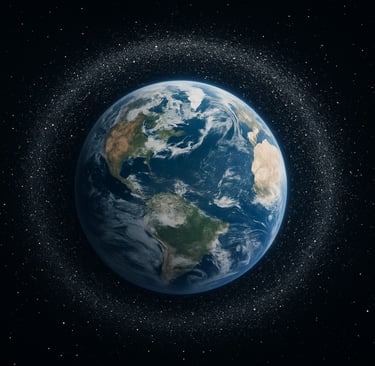We’re Fogging the Atmosphere With Dead Satellites
Humanity has unintentionally begun a massive geoengineering experiment by burning thousands of satellites into the stratosphere. Metallic nanoparticles from re-entry are now altering ozone chemistry, polar temperatures, and cloud formation all without regulation or public awareness.
SPACESCIENCE AND TECHNOLOGY
11/12/20254 min read


If you’d told me a decade ago that the biggest atmospheric experiment of the twenty-first century wouldn’t come from oil companies, governments, or a Bond-villain billionaire trying to “fix climate change” with a volcano-sized aerosol cannon, but from the cremation of broadband satellites, I’d have classed you somewhere between sleep-deprived and unwell. Yet here we are, learning that every time a satellite dies, it doesn’t simply burn up. It performs a sort of metallic last rite across the sky, scattering nanoparticles that linger for years.
Scientists finally sampled the stratosphere properly and found something alarming: about ten percent of the particles floating up there now contain telltale metals that shouldn’t be present in those quantities. Their composition matches modern spacecraft alloys with forensic neatness. Aluminium, lithium, copper, lead. Ingredients you’d expect to find on a factory floor or an engineering spec sheet, not drifting around in the sky like cosmic dandruff.
What makes this unsettling isn’t just the chemistry. It’s the contrast. Natural meteor dust contributes only a whisper of aluminium, a quiet geological background hum. Human-made satellites, on the other hand, dump so much metal into the upper atmosphere that our contribution has already overtaken the meteoritic background. We are, for the first time in history, polluting the stratosphere faster than space itself.
And we’re doing it at precisely the moment we like to imagine ourselves as a civilisation rising toward a higher calling. You know the narrative, the glossy one. Humanity as a species on the brink of becoming interplanetary. Rockets landing themselves. Lunar bases. Martian colonies. A grand voyage into the cosmic unknown. We market ourselves as pioneers, as a race destined for the stars.
But the truth is far less flattering. We can barely manage our own atmosphere, never mind another planet’s. We behave like a civilisation sprinting toward space while leaving its rubbish outside the airlock. The mythology we’ve built around ourselves, the one where we’re brave explorers of a boundless frontier, doesn’t square with the reality that we treat the sky like a casual dumping ground. It is the cosmic equivalent of boasting about your plans to sail around the world while emptying your bin bags into the harbour.
And the mechanism behind this ecological plot twist? A well-intentioned policy called Design for Demise. It ensures satellites disintegrate efficiently during re-entry so they don’t rain hardware across the suburbs. It’s a sensible idea, until you realise that the more efficiently a satellite burns, the more completely it transforms into a mist of aluminium oxide nanoparticles. We designed a safety system that doubles as a planetary aerosol dispenser. We didn’t just kick the problem down the road; we lofted it 80 kilometres straight up and pretended physics would handle the rest.
This wouldn’t matter much if the scale were small. But the scale is not small. A few years ago, the annual alumina load from satellite reentries was about seventeen tonnes. Irritating, but manageable. Fast forward to the present megaconstellation era and you’re looking at a projected 360 tonnes a year, just from routine operations. And by 2040, if deployment plans hold, the annual total climbs to ten thousand tonnes, a projection highlighted by NOAA. That’s the equivalent of roughly 150 Space Shuttles burning up every year, forever. At that point, you’re not dealing with pollution. You’re dealing with a slow-burn form of atmospheric engineering.
And this is where the implications sharpen.
Those metal particles don’t simply drift harmlessly. They interfere with ozone chemistry in ways that make researchers shift in their chairs. They provide surfaces on which catalytic reactions can strip ozone molecules apart, the same type of reactions that forced global action under the Montreal Protocol. Meanwhile, climate models suggest that enough alumina in the stratosphere can alter temperature gradients, wind speeds, and even weaken the polar vortex. Small shifts at first, subtle distortions in atmospheric circulation, but enough to remind us that the system is sensitive to everything we throw at it, even the things we pretend are insignificant.
And what’s genuinely staggering is how little conversation there’s been about any of this. No debate. No public consultation. No international summit. A fundamental chemical shift in the sky has occurred without anyone asking whether it might be wise to check, or monitor, or regulate. We’ve slipped into a planetary experiment with the casual carelessness of someone leaving a candle burning on the sofa and hoping the house understands their intentions.
Worse still, the particles don’t leave quickly. Some linger for years; others for decades. They accumulate. They compound. Even if launches stopped tomorrow, the atmospheric burden we’ve created would continue shaping the sky long into the mid-century. This is the bill that our pioneering mythology refuses to acknowledge. We cheer for Mars, we fantasise about space hotels and asteroid mining, and we talk as though the universe has already reserved our seat at the adult’s table, all while behaving like teenagers confident that someone else will tidy up later.
Our civilisation dreams of galaxies but struggles with bins.
We imagine ourselves ascending.
The evidence shows us terraforming our own sky by accident.
And maybe that’s the part that stings the most: not the pollution itself, but the contradiction. The gulf between who we think we are and how we actually behave.
If this is what we’re doing to our own planet without meaning to, imagine what we’d do to another one on purpose.
BurstComms.com
Exploring trends that shape our global future.
Sign up for the regular news burst
info@burstcomms.com
Get the next transmission:
© 2025. All rights reserved.
